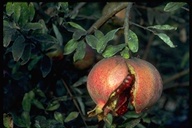Interactions
Punica granatum is involved in relationships with numerous other species in its environment. Pests such as white flies, thrips, mealybugs, scale insects, and Mediterranean fruit flies cause harm to the plant’s foliage, flowers, and fruit. These pests often excrete waste on the leaves and flowers of the pomegranate plant. This may prevent the buds from opening, which halts the reproductive life cycle of the plant.
 Spider mites may
also pose a threat to the plant by leaving behind silky strands.
This material damages the leaves, causing them to turn from
green to yellow. Sometimes the leaves even experience premature
detachment from the tree. Some pests cause the fruit to split
open before it is completely ripe, increasing its vulnerability
for further invasion.
Spider mites may
also pose a threat to the plant by leaving behind silky strands.
This material damages the leaves, causing them to turn from
green to yellow. Sometimes the leaves even experience premature
detachment from the tree. Some pests cause the fruit to split
open before it is completely ripe, increasing its vulnerability
for further invasion.
The pomegranate butterfly (Virachola isocrates) is notorious for releasing eggs on blossoms surrounding the growing pomegranate fruit. Eventually caterpillars emerge from these eggs and make their way into the fruit, causing destruction along the way.
Herbivores, such as mule deer, interact with Punica granatum. They nibble on the leaves and fruit as a means of acquiring nutrients. Bats, squirrels, and birds also consume the fruit.
Alternaria sp. is known to attack Punica granatum, causing rot within the fruit. A fungal pathogen, Alternaria sp. is currently classified with the Deuteromycetes due to its lack of a known sexual reproductive process. It thrives on breaking down cellulose. It often begins by infecting floral organs, but may also attack other parts of the plant. When infesting leaves, the fungus typically leaves behind concentric rings that form the look of a "bull's-eye."
 Pomegranate trees, like most other wooded plants, are prone to
termite infestation. However, like other trees, Punica
granatum also experiences a mutualistic relationship with
fungi. In a symbiosis referred to as endomycorrhizae, a
member of Glomeromycota interacts with the roots of the tree.
The fungus provides
the plant with minerals such as phosphate, copper, and zinc. The
tree benefits the fungus by providing it with glucose.
Pomegranate trees, like most other wooded plants, are prone to
termite infestation. However, like other trees, Punica
granatum also experiences a mutualistic relationship with
fungi. In a symbiosis referred to as endomycorrhizae, a
member of Glomeromycota interacts with the roots of the tree.
The fungus provides
the plant with minerals such as phosphate, copper, and zinc. The
tree benefits the fungus by providing it with glucose.
Obviously, humans interact with the pomegranate tree. However,
consumption of the fruit is only one small part of the
pomegranate’s importance to society. To learn more, visit
USES.
